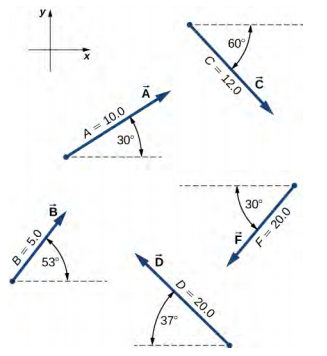18.2 : Vecteurs
- Page ID
- 191352
Vérifiez votre compréhension
2.1. a. Non égaux parce qu'ils sont orthogonaux ; b. non égaux parce qu'ils ont des magnitudes différentes ; c. pas égaux parce qu'ils ont des magnitudes et des directions différentes ; d. pas égaux parce qu'ils sont antiparallèles ; e. égaux.
2.2. 16 m ;\(\vec{D}\) = −16 m\(\hat{u}\)
2.3. G = 28,2 cm,\(\theta_{G}\) = 291 degrés
2.4. \(\vec{D}\)= (−5,0\(\hat{i}\) − 3,0\(\hat{j}\)) cm ; la mouche s'est déplacée de 5,0 cm vers la gauche et de 3,0 cm vers le bas depuis son site d'atterrissage.
2,5. 5,83 cm, 211°
2.6. \(\vec{D}\)= (−20 m)\(\hat{j}\)
2.7. 35,1 m/s = 126,4 km/h
2.8. \(\vec{G}\)= (10,25\(\hat{i}\) − 26,22\(\hat{j}\)) cm
2.9. D = 55,7 N ; direction 65,7° au nord de l'est
2.10. \(\hat{v}\)= 0,8\(\hat{i}\) + 0,6\(\hat{j}\), 36,87° au nord de l'est
2.11. \(\vec{A} \cdotp \vec{B}\)= −57,3,\(\vec{F} \cdotp \vec{C}\) = 27,8
2.13. 131,9°
2.14. L 1 = 1,5 J, L 2 = 0,3 J
2.15. \(\vec{A} \times \vec{B}\)= −40,1\(\hat{k}\) ou, de manière équivalente,\(\vec{A} \times \vec{B}\) | | = 40,1, et la direction est dans la page ;\(\vec{C} \times \vec{F}\) = + 157,6\(\hat{k}\) ou, de manière équivalente,\(\vec{C} \times \vec{F}\) | | = 157,6, et la direction est sortie de la page.
2.16. a. −2\(\hat{k}\), b. 2, vers 153,4°, d. 135°
Questions conceptuelles
1. Scalaire
3. Les réponses peuvent varier
5. Parallèle, somme des magnitudes, antiparallèle, zéro
7. Oui, oui
9. Zéro, oui
11. Non
13. Égal, égal, identique
15. Un vecteur unitaire de l'axe X
17. Ils sont égaux.
19. Oui
21. a. C =\(\vec{A} \cdotp \vec{B}\), b.\(\vec{C} = \vec{A} \times \vec{B}\) ou\(\vec{C} = \vec{A} - \vec{B}\), c.\(\vec{C} = \vec{A} \times\vec{B}\), d.\(\vec{C}\) = A\(\vec{B}\), e., f.\(\vec{C} + 2 \vec{A} = \vec{B}\)\(\vec{C} = \vec{A} \times \vec{B}\), g. Le côté gauche est un scalaire et le côté droit est un vecteur\(\vec{C} = 2 \vec{A} \times \vec{B}\), h., i.\(\vec{C} = \frac{\vec{A}}{B}\), j.\(\vec{C} = \frac{\vec{A}}{B}\)
23. Ils sont orthogonaux.
Problèmes
25. \(\vec{h}\)= −16,4 m\(\hat{u}\), 16,4 m
27. 30,8 m, 35,7° à l'ouest du nord
29. 134 km, 80°
31. 7,34 km, 63,5° au sud de l'est
33. 3,8 km à l'est, 3,2 km au nord, 7,0 km
35. 14,3 km, 65°
37. a.\(\vec{A}\) = + 8,66\(\hat{i}\) + 5,00\(\hat{j}\)
b.\(\vec{B}\) = + 3,01\(\hat{i}\) + 3,99\(\hat{j}\)
c.\(\vec{C}\) = + 6,00\(\hat{i}\) − 10,39\(\hat{j}\)
d.\(\vec{D}\) = −15,97\(\hat{i}\) + 12,04\(\hat{j}\)
f.\(\vec{F}\) = −17,32\(\hat{i}\) − 10,00\(\hat{j}\)

39. environ 1,94 km, 7,24 km
b. preuve
41. 3,8 km à l'est, 3,2 km au nord, 2,0 km,\(\vec{D}\) = (3,8\(\hat{i}\) + 3,2\(\hat{j}\)) km
43. P 1 (2,165 m, 1 250 m), P 2 (−1 900 m, 3 290 m), 5,27 m
45. 8,60 m, A (2\(\sqrt{5}\) m, 0,647\(\pi\)), B (3\(\sqrt{2}\) m, 0,75\(\pi\))
47. a.\(\vec{A} + \vec{B}\) = −4\(\hat{i}\) − 6\(\hat{j}\), |\(\vec{A} + \vec{B}\) | = 7,211,\(\theta\) = 236,3°
b.\(\vec{A} -\vec{B}\) = -2\(\hat{i}\) + 2\(\hat{j}\), |\(\vec{A} - \vec{B}\) | = 2\(\sqrt{2}\),\(\theta\) = 135°
49. a.\(\vec{C}\) = (5,0\(\hat{i}\) − 1,0\(\hat{j}\) − 3,0\(\hat{k}\)) m, C = 5,92 m
b.\(\vec{D}\) = (4,0\(\hat{i}\) − 11,0\(\hat{j}\) + 15,0\(\hat{k}\)) m, D = 19,03 m
51. \(\vec{D}\)= (3,3\(\hat{i}\) − 6,6\(\hat{j}\)) km,\(\hat{i}\) est à l'est, 7,34 km, −63,5°
53. a.\(\vec{R}\) = −1,35\(\hat{i}\) − 22,04\(\hat{j}\)
b.\(\vec{R}\) = −17,98\(\hat{i}\) + 0,89\(\hat{j}\)
55. \(\vec{D}\)= (200\(\hat{i}\) + 300\(\hat{j}\)) yd, D = 360,5 yd, 56,3° au nord de l'est ; Les réponses numériques resteraient les mêmes mais l'unité physique serait le mètre. La signification physique et les distances seraient à peu près les mêmes, car 1 yd est comparable à 1 m.
57. \(\vec{R}\)= −3\(\hat{i}\) − 16\(\hat{j}\)
59. \(\vec{E}\)= E\(\hat{E}\), E x = + 178,9 V/m, E y = −357,8 V/m, E z = 0,0 V/m,\(\theta_{E}\) = −tan −1 (2)
61. a.\(\vec{R}_{B}\) = (12 278\(\hat{i}\) + 7 089\(\hat{j}\) + 2 500\(\hat{k}\)) km,\(\vec{R}_{D}\) = (−0,262\(\hat{i}\) + 3 000\(\hat{k}\)) km
b. |\(\vec{R}_{B} − \vec{R}_{D}\) | = 14,414 km
63. environ 8,66
b. 10.39
environ 0,866
d. 17,32
65. \(\theta_{i}\)= 64,12°,\(\theta_{j}\) = 150,79°,\(\theta_{k}\) = 77,39°
67. a. −119,98\(\hat{k}\)
b. 0\(\hat{k}\)
c. +93,69\(\hat{k}\)
d. −240,0\(\hat{k}\)
E. +3 993\(\hat{k}\)
f. −3 009\(\hat{k}\)
g. +14,99\(\hat{k}\)
h. 0
69. un 0
b. 173 194
c. +199 993\(\hat{k}\)
Problèmes supplémentaires
71. a. 18,4 km et 26,2 km
b. 31,5 km et 5,56 km
73. a. (r\(\phi + \frac{\pi}{2}\)),
b. (2r,\(\phi + 2 \pi\))
c. (3r, −\(\phi\))
75. d PM = 33,12 km = 61,34 km, DP = 35,47 km = 65,69 km
77. preuve
79. environ 10,00 m
b. 5\(\pi\) mm, environ 0
81. 22,2 km/h, 35,8° au sud de l'ouest
83. 240,2 m, 2,2° au sud de l'ouest
85. \(\vec{B}\)= −4,0\(\hat{i}\) + 3,0\(\hat{j}\) ou\(\vec{B}\) = 4,0\(\hat{i}\) − 3,0\(\hat{j}\)
87. preuve
Problèmes liés au défi
89. G \(\perp\)= 2375\(\sqrt{17}\) ≈ 9792
91. preuve


